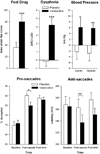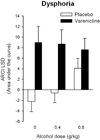Varenicline potentiates alcohol-induced negative subjective responses and offsets impaired eye movements
- PMID: 22339626
- PMCID: PMC3342420
- DOI: 10.1111/j.1530-0277.2011.01675.x
Varenicline potentiates alcohol-induced negative subjective responses and offsets impaired eye movements
Abstract
Background: Varenicline (VAR) is a partial nicotinic receptor agonist that is an effective smoking cessation medication. Preliminary evidence indicates that it may also reduce alcohol consumption, but the underlying mechanism is not clear. For example, VAR may reduce alcohol consumption by attenuating its subjectively rewarding properties or by enhancing its aversive effects. In this study, we examined the effects of an acute dose of VAR upon subjective, physiological, and objective responses to low and moderate doses of alcohol in healthy social drinkers.
Methods: Healthy men and women (N = 15) participated in 6 randomized sessions; 3 sessions each with 2 mg VAR and placebo (PL) followed 3 hours later by a beverage containing PL, low-dose alcohol (0.4 g/kg), or high-dose alcohol (0.8 g/kg). Subjective mood and drug effects (i.e., stimulation, drug liking), physiological measures (heart rate, blood pressure), and eye tracking tasks were administered at various intervals before and after drug and alcohol administration.
Results: VAR acutely increased blood pressure, heart rate, ratings of dysphoria and nausea, and also improved eye tracking performance. After alcohol drinking (vs. PL), VAR increased dysphoria and tended to reduce alcohol liking ratings. It also attenuated alcohol-induced eye-tracking impairments. These effects were independent of the drug's effects on nausea before drinking.
Conclusions: Our data support the theory that VAR may reduce drinking by potentiating aversive effects of alcohol. VAR also offsets alcohol-induced eye movement impairment. The evidence suggests that VAR may decrease alcohol consumption by producing effects, which oppose the rewarding efficacy of alcohol.
Copyright © 2012 by the Research Society on Alcoholism.
Figures




Similar articles
-
Varenicline reduces alcohol self-administration in heavy-drinking smokers.Biol Psychiatry. 2009 Jul 15;66(2):185-90. doi: 10.1016/j.biopsych.2009.01.029. Epub 2009 Feb 27. Biol Psychiatry. 2009. PMID: 19249750 Free PMC article. Clinical Trial.
-
Varenicline decreases alcohol consumption in heavy-drinking smokers.Psychopharmacology (Berl). 2012 Oct;223(3):299-306. doi: 10.1007/s00213-012-2717-x. Epub 2012 May 1. Psychopharmacology (Berl). 2012. PMID: 22547331 Free PMC article. Clinical Trial.
-
Varenicline effects on drinking, craving and neural reward processing among non-treatment-seeking alcohol-dependent individuals.Psychopharmacology (Berl). 2014 Sep;231(18):3799-807. doi: 10.1007/s00213-014-3518-1. Epub 2014 Mar 20. Psychopharmacology (Berl). 2014. PMID: 24647921 Free PMC article. Clinical Trial.
-
The nicotinic acetylcholine receptor partial agonist varenicline and the treatment of drug dependence: a review.Eur Neuropsychopharmacol. 2010 Feb;20(2):69-79. doi: 10.1016/j.euroneuro.2009.11.001. Epub 2009 Dec 3. Eur Neuropsychopharmacol. 2010. PMID: 19959340 Review.
-
Varenicline in the treatment of alcohol use disorders.Ann Pharmacother. 2014 Nov;48(11):1445-55. doi: 10.1177/1060028014545806. Epub 2014 Aug 5. Ann Pharmacother. 2014. PMID: 25095786 Review.
Cited by
-
Varenicline decreases nicotine but not alcohol self-administration in genetically selected Marchigian Sardinian alcohol-preferring (msP) rats.Drug Alcohol Depend. 2015 Nov 1;156:126-132. doi: 10.1016/j.drugalcdep.2015.09.002. Epub 2015 Sep 8. Drug Alcohol Depend. 2015. PMID: 26383997 Free PMC article.
-
Alcohol use disorder severity moderates clinical response to varenicline.Alcohol Clin Exp Res. 2021 Sep;45(9):1877-1887. doi: 10.1111/acer.14674. Epub 2021 Sep 5. Alcohol Clin Exp Res. 2021. PMID: 34486130 Free PMC article. Clinical Trial.
-
Alcohol Tolerance in Human Laboratory Studies for Development of Medications to treat Alcohol Use Disorder.Alcohol Alcohol. 2020 Mar 19;55(2):129-135. doi: 10.1093/alcalc/agz103. Alcohol Alcohol. 2020. PMID: 31950152 Free PMC article. Review.
-
Combination Treatment With Varenicline and Nicotine Patch on Smoking Cessation Outcomes in Heavy Drinkers at 26-Week Follow-up.J Clin Psychopharmacol. 2024 Jul-Aug 01;44(4):362-368. doi: 10.1097/JCP.0000000000001864. Epub 2024 May 16. J Clin Psychopharmacol. 2024. PMID: 38752924 Free PMC article. Clinical Trial.
-
Cognitive-Enhancing Effects of Acetylcholine Receptor Agonists in Group-Housed Cynomolgus Monkeys Who Drink Ethanol.J Pharmacol Exp Ther. 2024 May 21;389(3):258-267. doi: 10.1124/jpet.123.001854. J Pharmacol Exp Ther. 2024. PMID: 38135508 Free PMC article.
References
-
- Acheson A, Mahler SV, Chi H, De Wit H. Differential effects of nicotine on alcohol consumption in men and women. Psychopharmacology (Berl) 2006;186:54–63. - PubMed
-
- APA, American Psychiatric Association. Diagnostic and Statistical Manual of Psychiatry. 4th ed. Washington DC: 1994.
-
- Blomqvist O, Ericson M, Engel JA, Soderpalm B. Accumbal dopamine overflow after ethanol: localization of the antagonizing effect of mecamylamine. Eur J Pharmacol. 1997;334:149–156. - PubMed
-
- Blomqvist O, Hernandez-Avila CA, Van Kirk J, Rose JE, Kranzler HR. Mecamylamine modifies the pharmacokinetics and reinforcing effects of alcohol. Alcohol Clin Exp Res. 2002;26:326–331. - PubMed
Publication types
MeSH terms
Substances
Grants and funding
LinkOut - more resources
Full Text Sources
Medical

